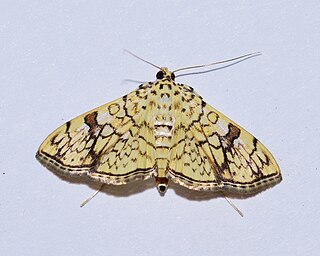
Ichneutica oliveri is a moth of the family Noctuidae. It is endemic to New Zealand, found only in the South Island. However it has not been observed on the eastern side of that island from mid-Canterbury southwards to Southland. This species is distinctive and is unlikely to be confused with other closely related species. It inhabits tussock grasslands, shrubland as well as granite sand plains, all in the alpine zone. Adults are on the wing from December to March and are attracted to light. They have been observed feeding on the flowers of Hebe species. The life history of this species is unknown as are the larval hosts.
Ambia albiflavalis is an African moth in the family Crambidae. It was described by George Hampson in 1917. The type locality is Nigeria.
Ambia chrysogramma is a moth in the family Crambidae. It was described by George Hampson in 1917. It is found on Samoa.
Apilocrocis albipunctalis is a moth in the family Crambidae. It was described by George Hampson in 1918. It is found in Ecuador and Bolivia.

Haritalodes polycymalis is a species of moth in the family Crambidae. It was described by George Hampson in 1912. It is found in sub-Saharan Africa from Sierra Leone to South Africa.
Syllepte tumidipes is a moth in the family Crambidae. It was described by George Hampson in 1912. It is found in Cameroon, the Democratic Republic of the Congo, Gabon, Ghana, Nigeria and Sierra Leone.
Catephia pyramidalis is a species of moth of the family Erebidae. It is found in Kenya.
Catephia poliochroa is a species of moth of the family Erebidae. It is found in Kenya.
Polygrammodes semirufa is a moth in the family Crambidae. It was described by George Hampson in 1913. It is found in São Paulo, Brazil.
Pycnarmon peruvialis is a moth in the family Crambidae. It was described by George Hampson in 1917 and it is found in Peru.
Sinomphisa junctilinealis is a moth in the family Crambidae. It is found in Sierra Leone and Uganda.
Sufetula polystrialis is a moth in the family Crambidae. It was described by George Hampson in 1912. It is found on the Louisiade Islands.
Syllepte crenilinealis is a moth in the family Crambidae. It was described by George Hampson in 1918. It is found in Western New Guinea, Indonesia.
Synclera retractilinea is a moth in the family Crambidae. It was described by George Hampson in 1917. It is found in Kenya.
Syngamia albiceps is a moth in the family Crambidae. It was described by George Hampson in 1912. It is found in Singapore.
Udea melanostictalis is a moth in the family Crambidae. It was described by George Hampson in 1916. It is found in Kenya.
Udeoides nigribasalis is a moth in the family Crambidae. It was described by George Hampson in 1913. It is found in Kenya.
Ulopeza denticulalis is a species of moth in the family Crambidae. It was described by George Hampson in 1912. It is found in South Africa.
Ambia cymophoralis is a moth in the family Crambidae described by George Hampson in 1917. It is found on St Aignan Island in the Louisiade Archipelago of Papua New Guinea.
Ambia fulvicolor is a moth in the family Crambidae. It was described by George Hampson in 1917 and it is found in New Guinea.

